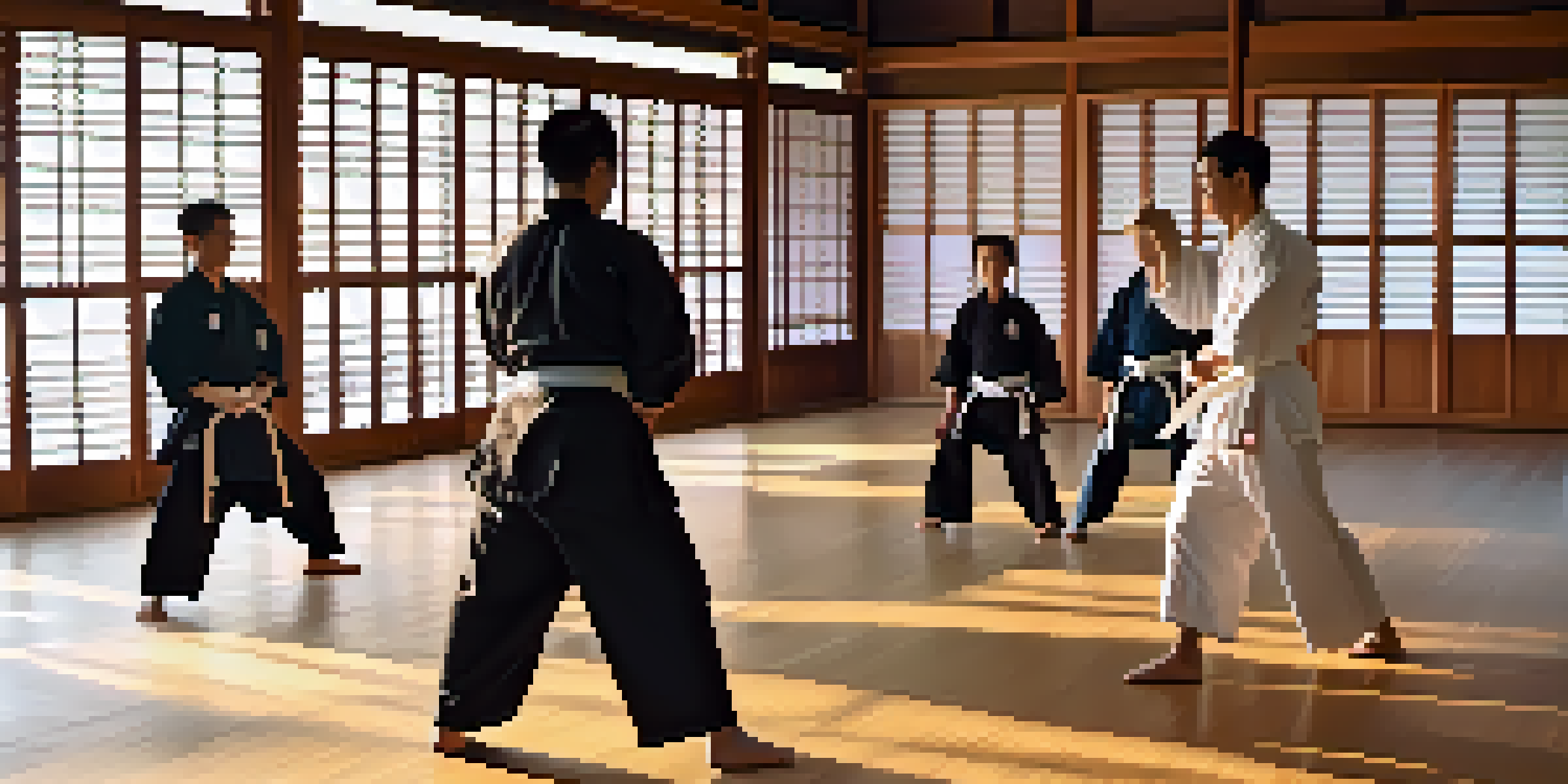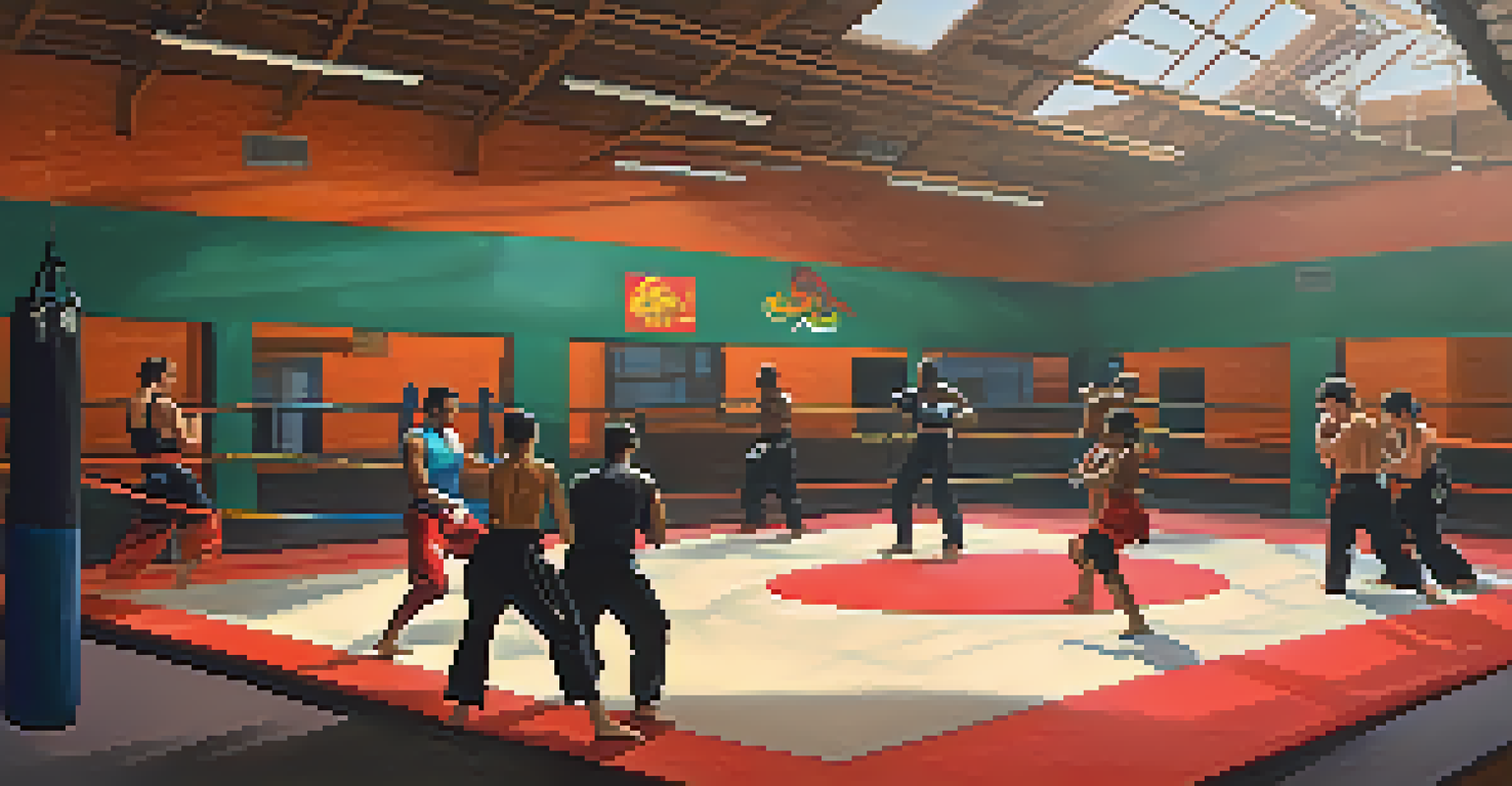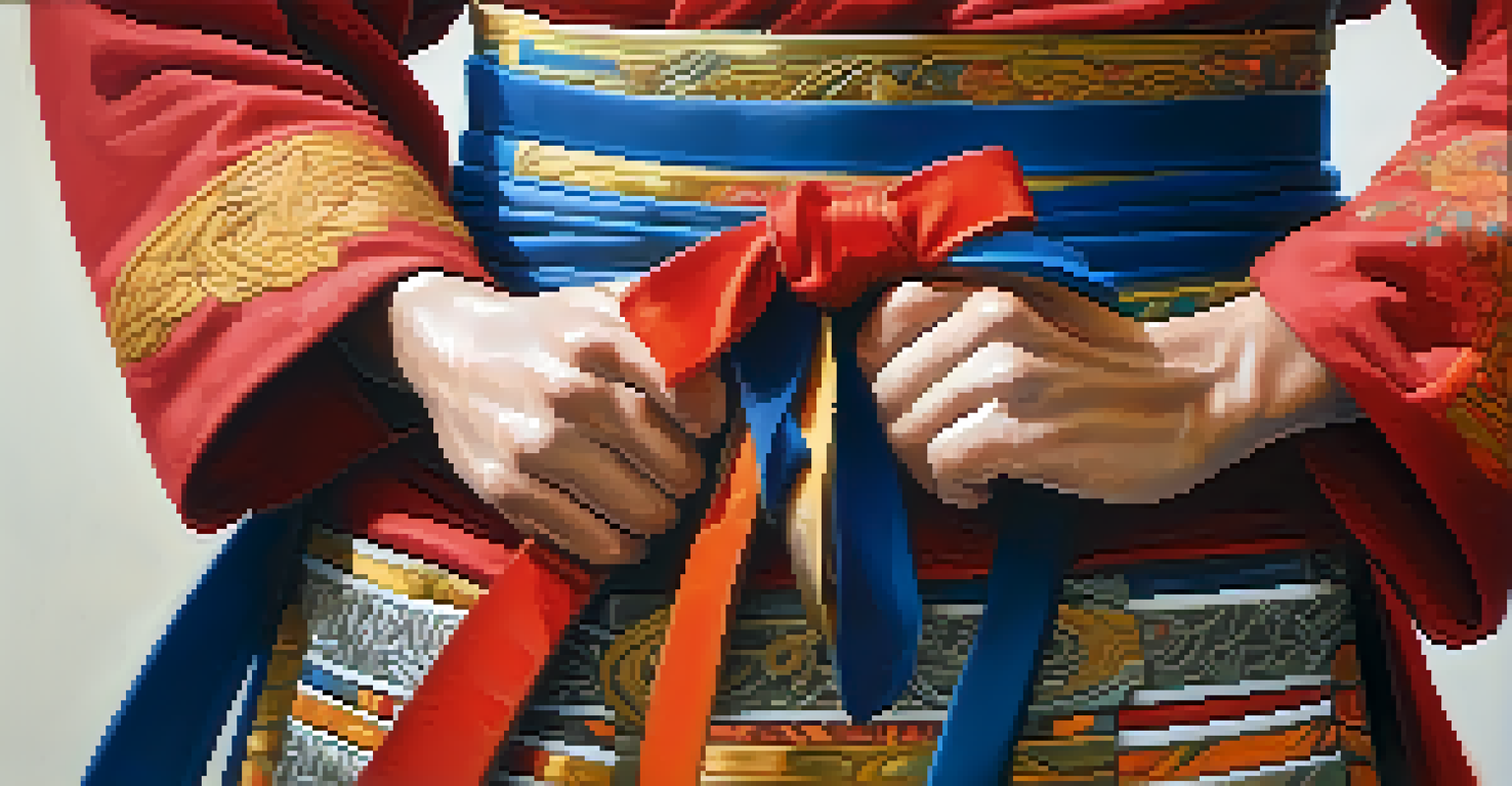The Influence of Traditional Martial Arts on Modern Practices

Understanding Traditional Martial Arts and Their Roots
Traditional martial arts encompass a variety of fighting styles, often steeped in history and culture. They originated in different regions, each with unique philosophies, techniques, and training methods. For instance, karate from Japan emphasizes striking techniques, while kung fu from China includes fluid movements and forms. These arts not only focus on physical skills but also on mental discipline and ethical values.
Martial arts are a way of life, a philosophy that extends beyond the dojo and into everyday living.
Each martial art tells a story, reflecting the culture and society it comes from. The teachings often include respect, honor, and self-discipline, shaping practitioners' character. This rich heritage provides a foundation that many modern practices draw from, creating a bridge between past and present. Understanding these roots helps us appreciate the evolution of martial arts over the years.
As we explore the influence of traditional martial arts today, it's essential to recognize how these foundational elements continue to resonate. Many modern martial arts schools incorporate these philosophies, ensuring that the essence of traditional practices remains alive. This connection between old and new not only enriches training but also fosters a sense of community and belonging among practitioners.
Transitioning Techniques: From Tradition to Modernity
One of the most significant influences of traditional martial arts on modern practices is the adaptation of techniques. Many contemporary martial arts, such as MMA (Mixed Martial Arts), incorporate techniques from various traditional styles, creating a hybrid form. This blending allows for a more versatile skill set, appealing to practitioners seeking comprehensive training. For example, the kicks from taekwondo and grappling techniques from jiu-jitsu are now commonplace in MMA.

Moreover, the focus on practical self-defense has led to the evolution of certain techniques. Traditional movements that may have been ceremonial or less applicable in a modern context are often refined to meet current needs. This adaptation showcases how martial arts can evolve while maintaining their core principles, making them relevant in today’s world.
Tradition Shapes Modern Practices
Traditional martial arts provide foundational techniques and philosophies that continue to influence contemporary martial arts training.
The shift from traditional forms to modern applications highlights the ongoing dialogue between past and present. As martial arts continue to develop, practitioners often find inspiration in their foundational styles, ensuring the integrity of traditional techniques lives on. This dialogue not only enhances physical capabilities but also deepens the understanding of martial arts as a lifelong journey.
Philosophy and Mindset: The Heart of Martial Arts
The philosophical aspects of traditional martial arts greatly influence modern practices. Concepts such as mindfulness, respect for others, and perseverance are central to many martial arts. These principles are not just about fighting; they cultivate a mindset that practitioners carry into their daily lives. This holistic approach fosters resilience and emotional intelligence, qualities that are increasingly valued in today’s fast-paced world.
In martial arts, the mind is as important as the body; it is the marriage of the two that creates a true martial artist.
In modern training environments, instructors often emphasize these philosophical teachings, integrating them into lessons. For instance, students might engage in meditation or reflection as part of their practice, allowing them to connect more deeply with their training. This incorporation of philosophy helps bridge the gap between physical training and mental development, reinforcing the idea that martial arts is a way of life.
As more people discover the benefits of this mindset, traditional martial arts continue to inspire modern practices across various disciplines. The influence of these philosophies can be seen in areas like corporate leadership training and personal development seminars, where the principles of martial arts are applied to enhance performance and teamwork. This cross-pollination of ideas illustrates the timeless relevance of martial arts teachings.
Physical Conditioning: Endurance and Strength Training
Traditional martial arts have long been recognized for their rigorous physical conditioning. Practitioners engage in exercises that develop strength, flexibility, and endurance, laying a solid foundation for effective performance. Many modern fitness regimens borrow elements from these conditioning techniques, recognizing their effectiveness in building overall fitness. For instance, kickboxing classes often incorporate traditional striking techniques to offer a full-body workout.
Additionally, the emphasis on body control and awareness in traditional martial arts translates well to modern training. Many contemporary fitness programs focus on functional movements, which are also key components in martial arts training. This shared focus on physical capability allows practitioners to enhance their skills while improving their overall health and fitness levels.
Community Builds Strong Connections
The camaraderie fostered in martial arts training environments creates lasting friendships and a supportive community.
As the popularity of martial arts-inspired fitness continues to rise, more people are discovering the benefits of this training style. Traditional conditioning methods not only improve physical performance but also promote mental toughness. This dual focus is what makes martial arts training appealing to a wide audience, from competitive athletes to those seeking a healthier lifestyle.
Community and Camaraderie: Building Bonds Through Training
One of the most rewarding aspects of traditional martial arts is the sense of community it fosters. Training often takes place in a dojo or studio, where practitioners develop friendships and support each other. This camaraderie can be seen in group classes, sparring sessions, and belt promotions, creating a shared experience that strengthens bonds. The encouragement and support from fellow practitioners help individuals push through challenges and celebrate achievements together.
Modern martial arts schools often emphasize this community aspect, organizing events and social gatherings that bring practitioners together. These activities not only enhance training but also create lasting friendships that extend beyond the dojo. From local tournaments to community service projects, martial arts practitioners often come together to support one another and give back.
The sense of belonging that comes from joining a martial arts community is invaluable. As individuals find their place within this supportive environment, they often experience a boost in confidence and motivation. This dynamic contributes to the overall growth and development of each practitioner, further intertwining traditional values with modern practices.
Globalization: The Spread of Martial Arts Worldwide
The globalization of traditional martial arts has significantly impacted modern practices, allowing techniques and philosophies to reach diverse audiences. With the rise of the internet and social media, martial arts enthusiasts from different backgrounds can share knowledge and connect with one another. This exchange of ideas has led to the development of new styles and training methods, reflecting a blend of cultural influences.
As martial arts spread across the globe, practitioners often adapt techniques to suit their local contexts. This fusion results in unique interpretations of traditional styles, making them more accessible to a wider audience. For example, the emergence of urban martial arts classes incorporates elements of street culture, appealing to younger generations while maintaining core principles.
Globalization Enhances Cultural Exchange
The spread of martial arts worldwide promotes a blend of cultural influences, enriching training experiences for practitioners.
The global nature of martial arts also enhances cultural exchange, promoting mutual respect and understanding among practitioners. As individuals learn from one another, they carry forward the teachings of their respective traditions, creating a rich tapestry of martial arts practices. This interconnectedness not only enriches individual training experiences but also strengthens the global martial arts community.
The Future of Martial Arts: Blending Tradition with Innovation
Looking ahead, the future of martial arts seems promising as traditional practices continue to inspire innovation. As new training technologies emerge, such as virtual reality and online classes, martial arts schools are finding creative ways to engage students. These advancements allow practitioners to explore techniques in new ways while still honoring traditional values. For example, online platforms enable students to learn from masters worldwide without geographical limitations.
Moreover, the integration of science and research into martial arts training is shaping its future. Understanding biomechanics and exercise physiology can lead to improved training techniques and injury prevention strategies. As practitioners embrace these insights, they can enhance their performance while preserving the essence of traditional training.

Ultimately, the future of martial arts will likely be a harmonious blend of tradition and innovation. By respecting the roots while embracing new ideas, practitioners can continue to evolve and improve. This adaptability ensures that martial arts remain relevant and impactful for generations to come, inspiring individuals on their personal journeys.